Physical Address
304 North Cardinal St.
Dorchester Center, MA 02124
Inguinal hernias have been documented since the dawn of recorded history. The term “hernia” comes from the Greek hernios, meaning offshoot or bud. Because an inguinal hernia is present in many different species of animals, particularly primates, prehistoric humans likely suffered from this condition as well.
The Egyptian Ebers papyrus from 1550 bc describes the diagnosis and treatment of an inguinal hernia. Also, mummies (e.g., Ramses V, 1157 bc ) from ancient Egypt have been found to have inguinal hernias. Hernias were mentioned in the Hippocratic Corpus in ancient Greece. During the Roman Empire, Celsus (c. 25 bc to c. 50 ad ) described hernia reduction and treatment (ligation, sparing the testis) in de Re Medica. Galen (b. 129 ad ) later described the processus vaginalis and defined hernias as a rupture of the peritoneum. He advised ligation of the sac and cord with sacrifice of the testicle. Galen’s recommendations were followed for centuries. Arabic surgeons (Albucasis, 1114–1187) recommended treating an inguinal hernia by cauterization, and this technique was adopted by some Western surgeons during the Middle Ages. Ambrose Paré (1510–1590) recommended conservative treatment but also described ligation of inguinal hernias in childhood and advocated against removal of the testis.
The advent of anesthesia and antisepsis in the mid-1800s paved the way for refinements in the treatment of inguinal hernias. Bassini described internal inguinal ring tightening and reinforcement of the posterior canal in 1887. His recurrence and infection rates after over 200 repairs were approximately 5%. Gross reported a 0.45% recurrence rate in a large series of hernia repairs in 3874 children in 1953. The first laparoscopic hernia repair was reported by Ger in 1982.
The overall lifetime incidence of an inguinal hernia is estimated to be approximately 5% for males. Inguinal hernias in males are 5–10 times more common than in females. The age at presentation of an inguinal hernia also varies by gender. A database review of nearly 80,000 children from Taiwan found the peak incidence of an inguinal hernia in males to be under 1 year of age and 4.7 years in females. In that study, hernias were much more common under 1 year of age, with a decreasing incidence thereafter. Incarceration was found to be equally common in males and females.
Hernias are about twice as common on the right and are bilateral in about 10% of patients. Bilateral hernias are nearly twice as common in girls. A Swedish population-based study found that there was a twofold increase in the odds of developing an inguinal hernia when a sibling was found to have an inguinal hernia. A family history of inguinal hernia is found in 10–25% of children with an inguinal hernia. There is an increased incidence in twins, more frequently in male twins.
The abdominal cavity is lined by the parietal peritoneum, and an outpouching in front of the testis and gubernaculum in boys, known as the processus vaginalis, is first seen during the 2nd or 3rd month of gestation. Germ cells are found in the urogenital ridge by the 6th week of gestation. By the 7th week, the testes have begun to differentiate. Testicular descent occurs in two stages: the first is an abdominal phase (8–15 weeks gestation) with swelling and strengthening of the distal gubernaculum under the influence of insulin-like hormone 3 (Insl3). The swelling causes the gubernaculum to maintain a fixed length in males. At the same time, fetal testosterone causes regression of the cranial suspensory ligament. The testis is thus anchored to the internal ring while the abdominal cavity increases in size. By 25–35 weeks (inguinoscrotal phase), the gubernaculum extends down to the base of the scrotum. Androgenic hormones lead to release of neurotrophins that regulate the sensory branches of the genitofemoral nerve. Calcitonin gene-related peptide (CGRP) release provides a local chemotactic gradient to guide the gubernaculum. The testis then passes through the inguinal canal and eventually reaches the base of the scrotum. The female anlage of the processus vaginalis is the canal of Nuck, a structure that leads to the labia majora. This also closes by about 7 months of fetal life, and ovarian descent is arrested in the pelvis.
Once testicular descent is complete, obliteration of the patent processus vaginalis (PPV) usually occurs. Initial closure of the internal inguinal ring is followed by obliteration of the part of the processus vaginalis superior to the testis. The residual space between the cranial and caudal portions (funicular process) is normally the last to obliterate. Failure of obliteration results in an indirect inguinal hernia or hydrocele ( Fig. 50.1 ). Factors driving PPV closure are incompletely understood. Disorders with increased abdominal pressure/fluid (e.g., ascites, chronic cough) are associated with an increased incidence of indirect inguinal hernias as well as bilaterality. Prematurity results in delivery prior to completion of normal descent and obliteration, and is associated with an increased incidence of inguinal hernia ranging from 10–30%, depending on the degree of prematurity.
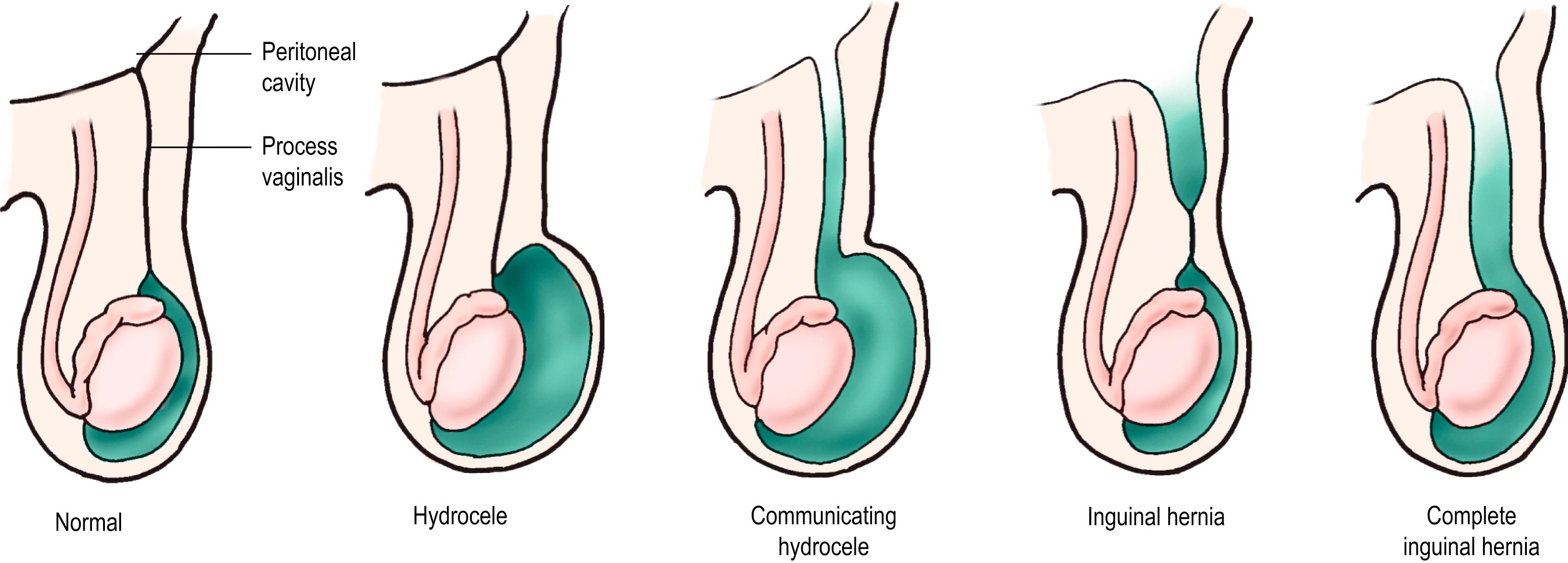
The layers of the abdominal wall contribute to the layers of the testis and spermatic cord as the gonad descends. The internal spermatic fascia is a continuation of the transversalis fascia, the cremaster muscle derives from the internal oblique, and the external spermatic fascia originates from the external oblique aponeurosis. The processus vaginalis envelops the testis as the visceral and parietal layers of the tunica vaginalis.
Many conditions are associated with an inguinal hernia ( Box 50.1 ). The most common association is prematurity due to interruption of the normal process of testicular descent as well as comorbidities (e.g., chronic lung disease) in this population.
Prematurity
Family history
Cystic fibrosis and meconium peritonitis
Hydrocephalus (ventriculoperitoneal shunt)
Peritoneal dialysis
Ascites
Genitourinary abnormalities
Connective tissue disorders
Mucopolysaccharidoses
Glycogen storage diseases
Abdominal wall defects
Chronic lung disease
Cystic fibrosis (CF) carries an increased incidence (15%) of inguinal hernia. An increased risk of inguinal hernia in unaffected fathers and siblings of these children suggests genetic factors may be involved in addition to the mechanical effects of chronic lung disease and increased intra-abdominal pressure. The well-recognized vasal abnormalities in children with CF support an embryologic component. Along with many of the other conditions in Box 50.1 , CF is also a risk factor for bilaterality and recurrence.
Occasionally, a small or absent vas is found during inguinal hernia repair in males. Renal ultrasound (US) should be electively obtained to evaluate for associated ipsilateral renal agenesis. Abnormalities of the vas should also prompt an evaluation for CF ( Fig. 50.2 ). Congenital absence (bilateral or unilateral) of the vas is a heterogeneous disorder, largely due to mutations in the CF gene. Differing genotypes are noted with congenital absence of the vas as an isolated entity versus congenital absence of the vas in association with renal anomalies.
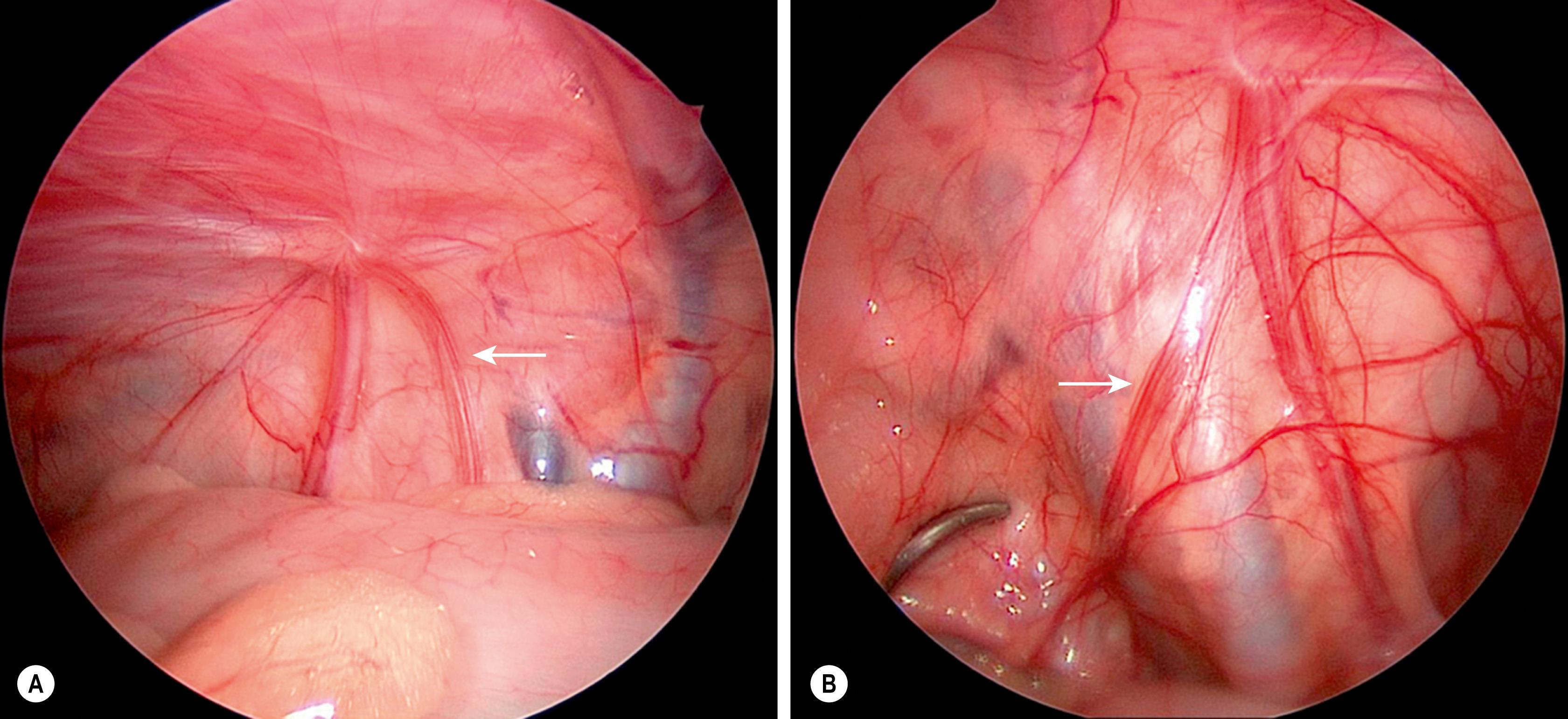
Ventriculoperitoneal shunts (VPSs) for hydrocephalus are associated with an increased incidence of inguinal hernia (15–25%) and higher rates of bilaterality, incarceration, and recurrence. Inguinal hernias are more likely to develop in neonates than in older children who undergo VPS and are more common in boys than girls. The average time from placement of a VPS to inguinal hernia repair is around 5–12 months. Other conditions in which excess intra-abdominal fluid is present (peritoneal dialysis, ascites, hydrops) have similar associations.
The term inguinal hernia includes indirect inguinal hernias, direct hernias, and femoral hernias. Indirect inguinal hernias, lateral to the inferior epigastric vessels, are by far the most common in children. Even in young adults (16–18 years of age), direct inguinal hernias are uncommon. Femoral hernias (inferior to the inguinal ligament) ( Fig. 50.3 ) account for less than 1% of pediatric inguinal hernias.
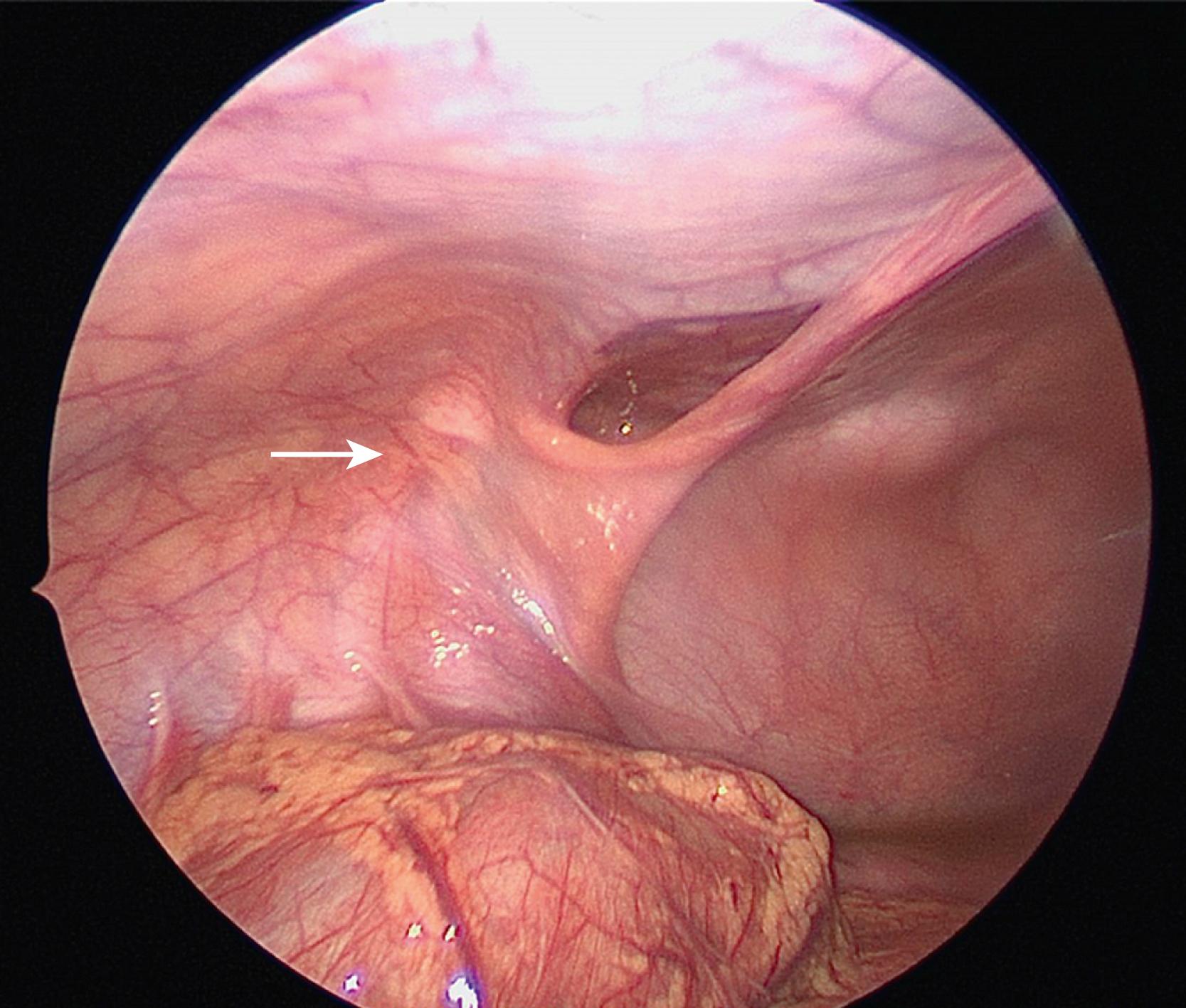
Sliding hernias are those in which viscera (bowel, bladder, reproductive structures) compose part of the hernia sac ( Fig. 50.4 ). Pantaloon (the term is derived from baggy trousers gathered at the ankles) hernias consist of direct and indirect inguinal hernias and are more common in neonates. Eponymous inguinal hernias include Amyand (appendix in the hernia sac) ( Fig. 50.5 ), Littre (Meckel diverticulum in the sac), and Richter (ischemic antimesenteric bowel border in the hernia) hernias.
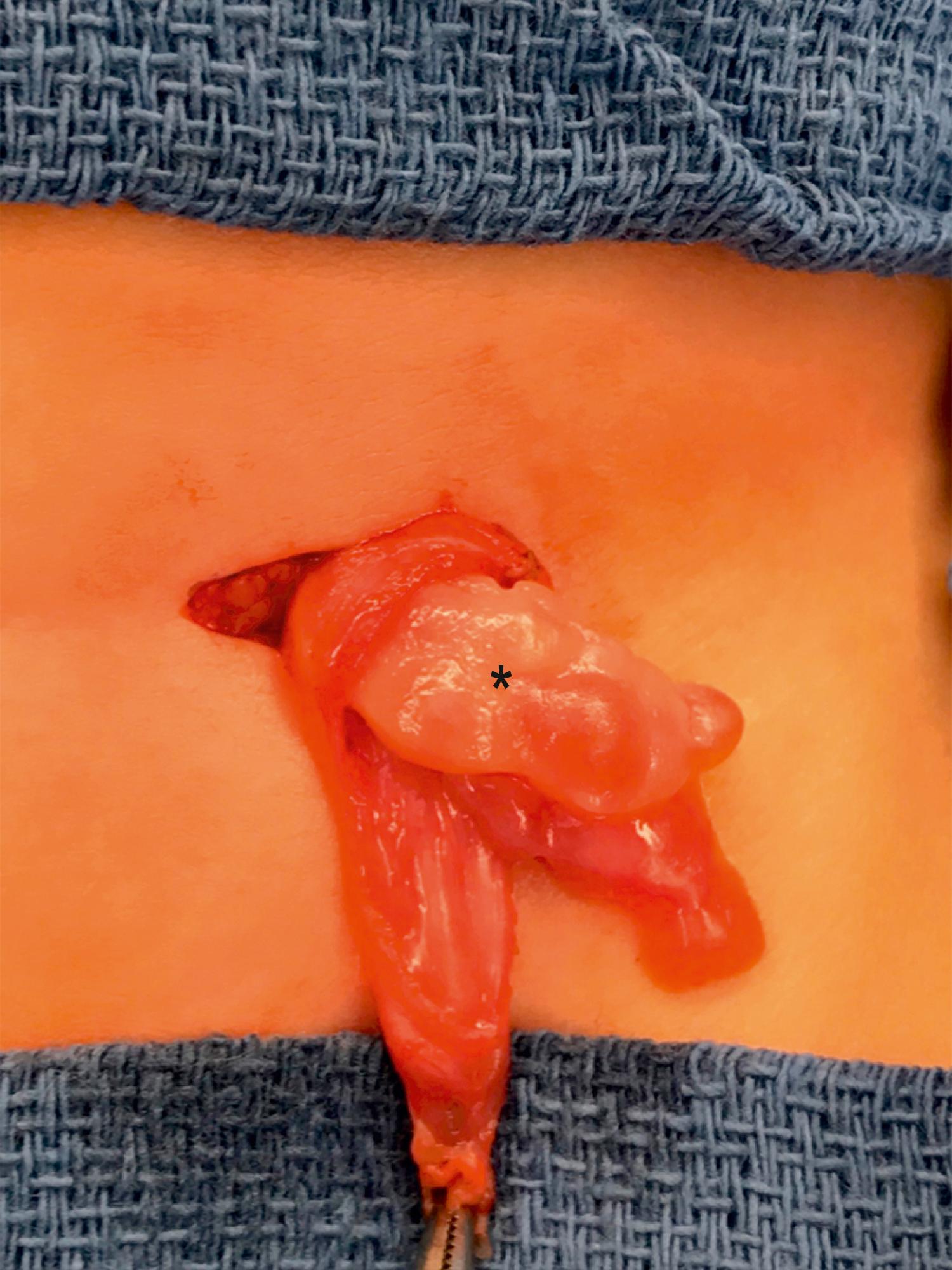
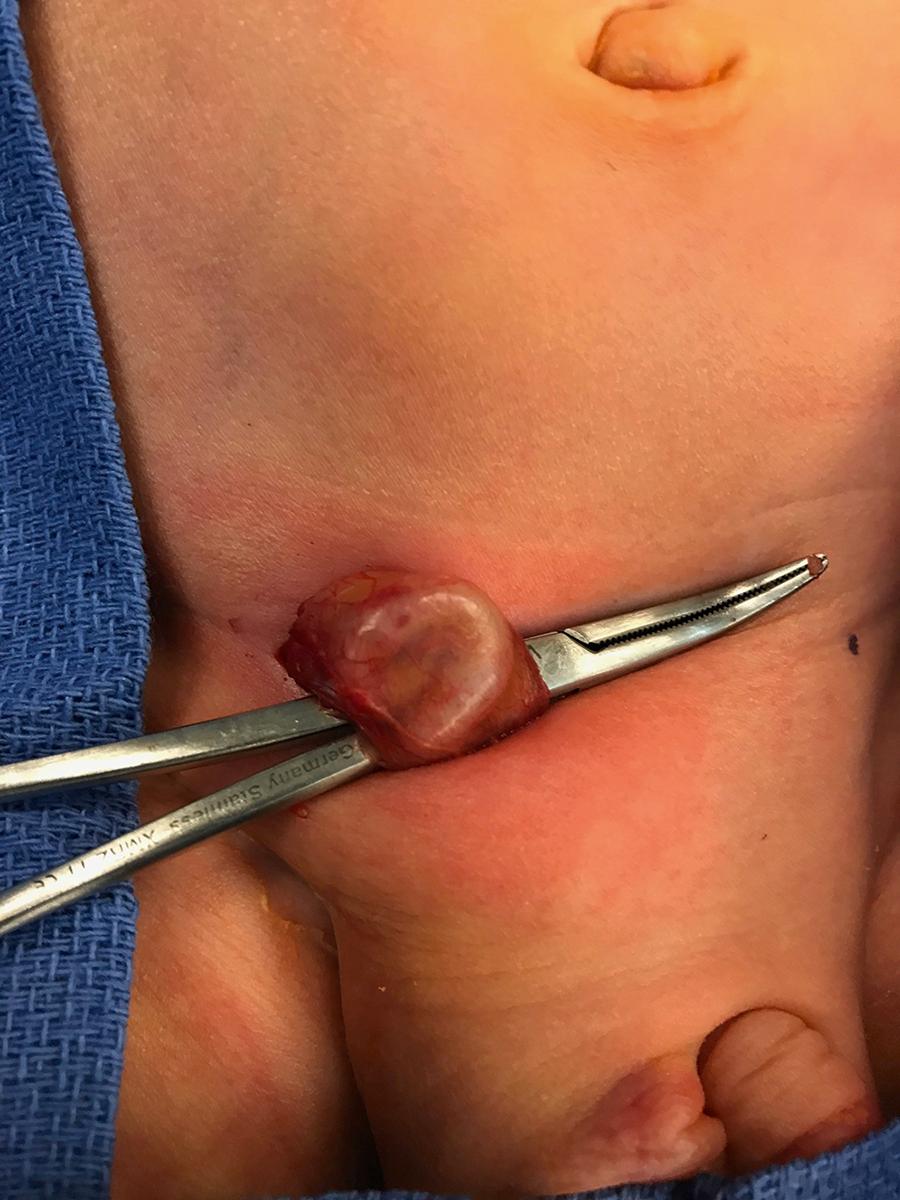
The diagnosis of an inguinal hernia is clinical and rests on the history and physical examination. The usual presentation of a hernia in a child is an asymptomatic, intermittent, unilateral inguinal bulge ( Fig. 50.6 ). On occasion, an infant or young child can present with bilateral inguinal hernias ( Fig. 50.7 ). Activities that increase intra-abdominal pressure (crying, coughing, straining, etc.) can elicit the hernia. Most are found by the parents or the pediatrician on routine physical examination.
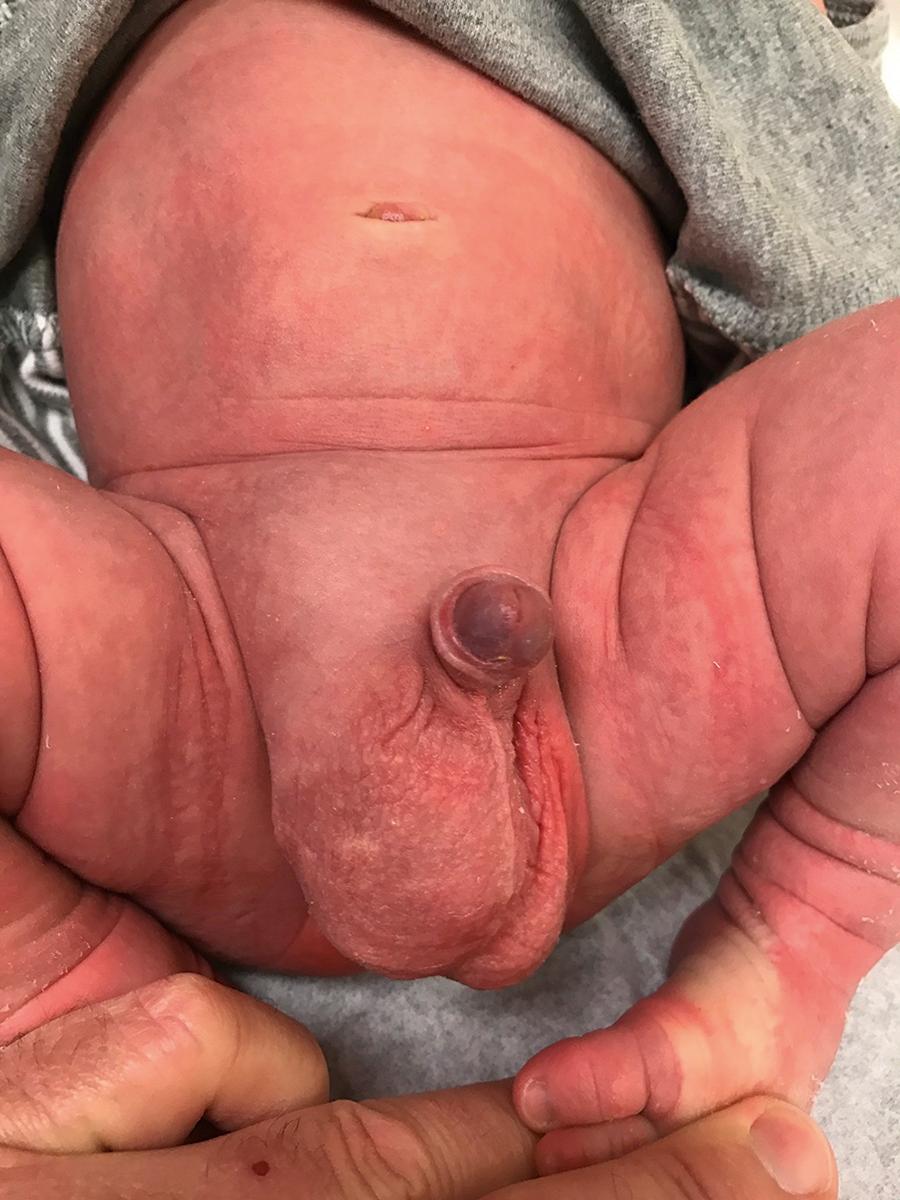
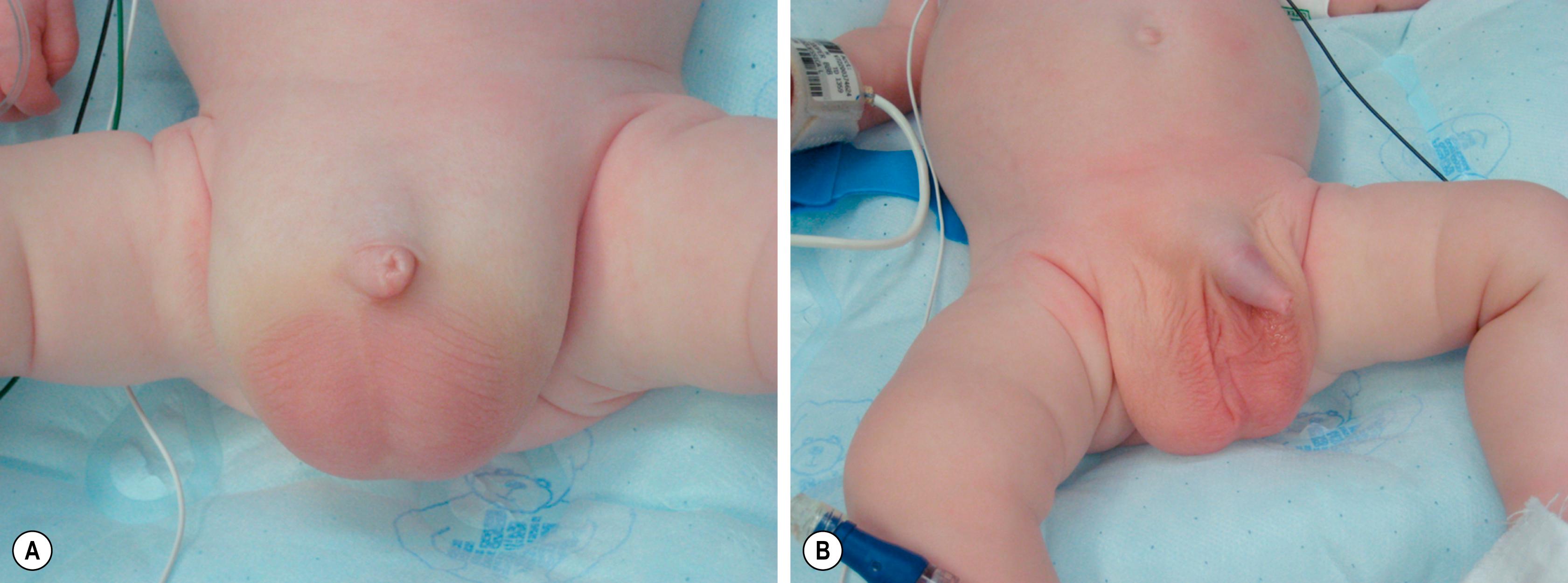
Because the inguinal bulging is intermittent, it is common to have a normal examination and a suggestive history. Cell phone picture documentation by the parents has become commonplace. A convincing history is acceptable as an indication for operation, particularly when diagnostic laparoscopy in questionable cases enables definitive diagnosis and repair.
Pertinent elements of the history include prior prematurity, family history, prior genitourinary anomalies (undescended testis, hypospadias, hydrocele), and the presence or absence of the associated factors (see Box 50.1 ). The differential diagnosis includes retractile testis, lymphadenopathy, hydrocele, varicocele, and prepubertal fat.
A frequent referral is a child with inguinal pain, no history of bulging or swelling, and a normal physical examination. Other sources such as musculoskeletal strain, gastrointestinal, or genitourinary causes should be excluded before operative intervention. Diagnostic laparoscopy is useful in those with equivocal examinations or persistent symptoms and no other apparent cause.
The most common examination finding is a reducible inguinal or scrotal bulge, more prominent during Valsalva maneuvers. Having the child raise the head while supine, or “blowing up a balloon” with a thumb in the mouth, may be helpful in small children. Standing the child upright also may help demonstrate the hernia. The “silk glove sign’” (feeling the thickened peritoneum of the patent processus as the cord is palpated) is examiner-dependent but can have more than 90% sensitivity in experienced hands. In girls, a hard mass may sometimes be felt if the ovary protrudes into the sac.
Radiologic assessment is not usually necessary or helpful. US can be used to identify a PPV indirectly via widening of the internal inguinal ring (more than 4–5 mm is positive), but the technique is highly operator dependent and not widely used in children. In a few reports, US has been used to identify a contralateral PPV.
The presence of fluid in the scrotum or inguinal canal in boys or in the inguinal/labial area in girls is indicative of a hydrocele ( Fig. 50.8 ). These are commonly seen in infancy, with a secondary peak in adolescent boys.
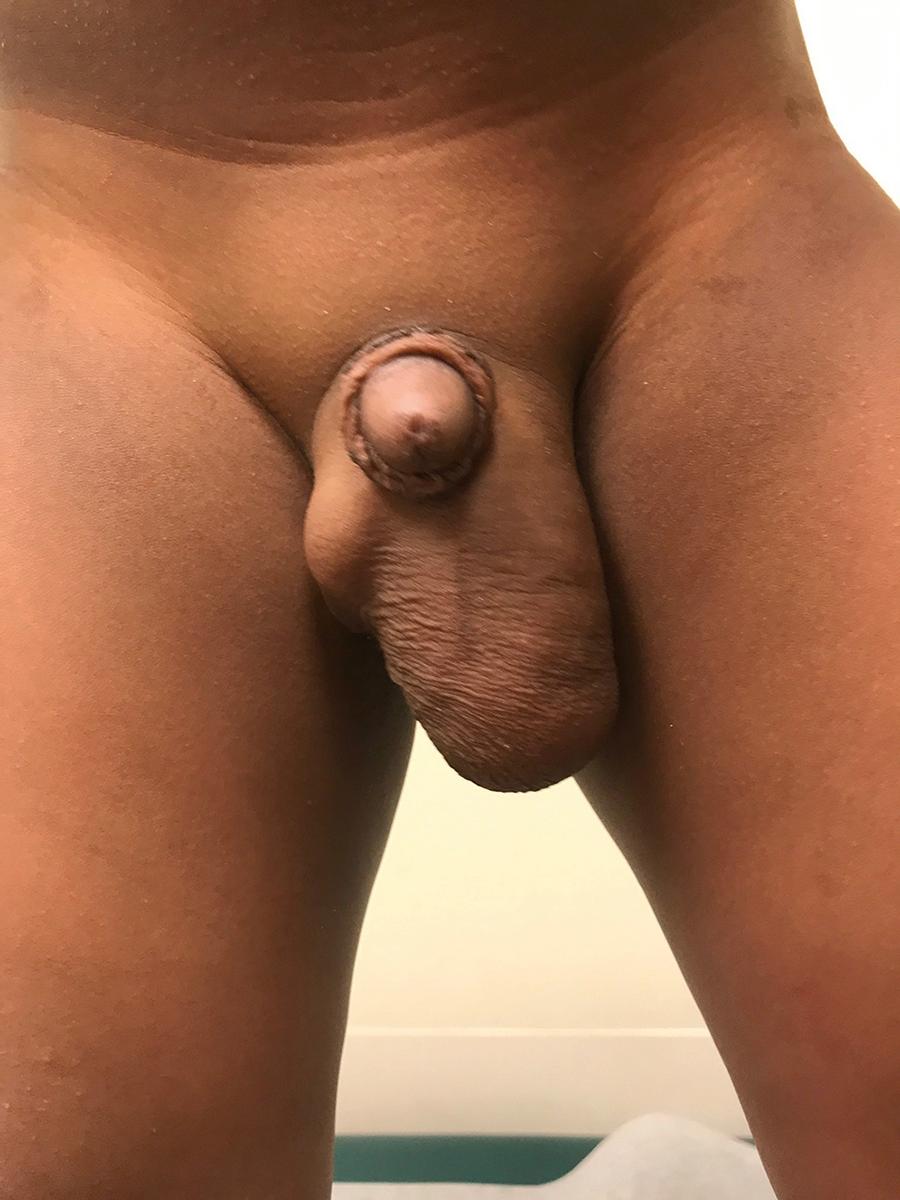
Hydroceles in infants are usually managed expectantly in the absence of evidence of communication indicating a PPV ( Fig. 50.9 ). Factors indicating communication include development of a new hydrocele after birth, waxing and waning in the size of the fluid collection, and failure to resolve by 1–2 years of age. Most surgeons observe noncommunicating hydroceles until the child reaches 1–2 years of age.
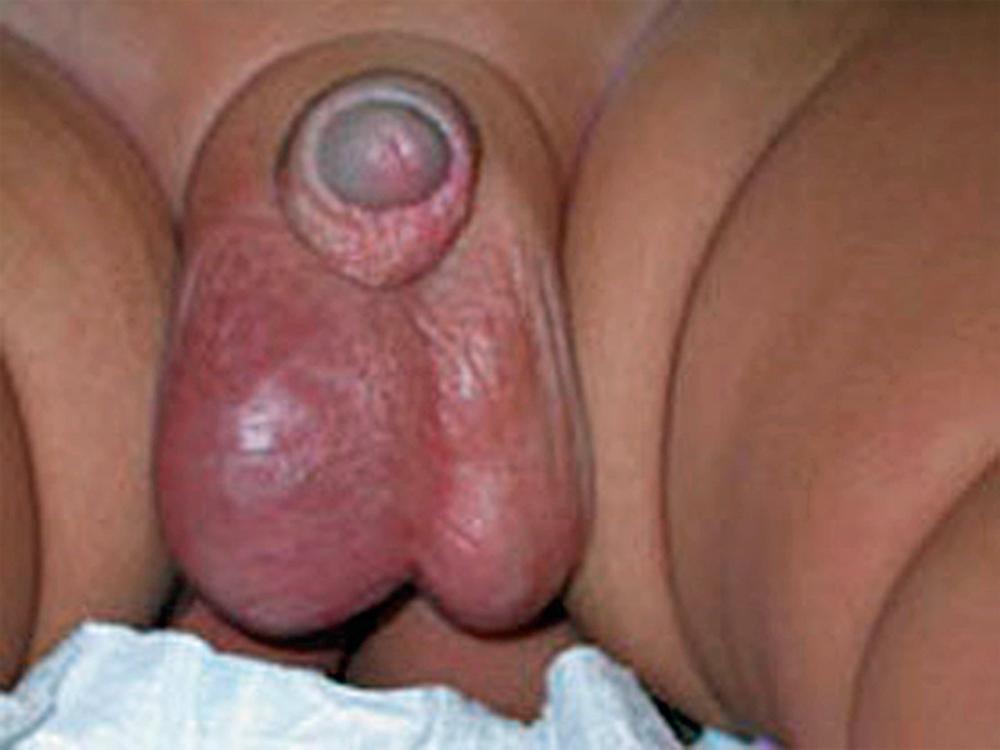
Communicating hydroceles in infants are treated as a hernia and repaired electively after diagnosis by some surgeons, whereas others advocate observation and expectant management. Surveys of North American pediatric surgeons in 1996 and 2003 found that observation for communicating hydroceles was preferred by only one-third in 1996 and 54% in 2005. A 2017 survey in the United Kingdom noted that most (61%) pediatric surgeons and urologists did not distinguish between communicating and noncommunicating hydroceles, and most deferred repair until 2–3 years of age. Resolution of apparently communicating, asymptomatic hydroceles is reported in 60–90% of cases.
Hydrocele of the cord is due to obliteration of the proximal and distal processus, with retention of a fluid-filled sac along the spermatic cord. On examination, a smooth sausage-link mobile mass is palpable in the inguinal canal. It can sometimes be difficult to distinguish cord hydroceles from an incarcerated inguinal hernia, particularly in an irritable baby who has undergone attempted reduction by other examiners. US may be helpful in this situation. As with communicating hydroceles in infants, management of cord hydroceles is controversial, with some favoring operation and others observation. Giant hydroceles (there is no objective definition) are considered an indication for operation by some surgeons, even without evidence of communication.
Abdominoscrotal hydrocele is an unusual entity. These are large scrotal masses with inguinoscrotal and abdominal components in a dumbbell configuration. The diagnosis is suggested by the “springing back ball” sign: cross-fluctuation in which compression of the scrotal component causes protrusion of the abdominal component and vice versa. Laparoscopy can be confirmatory. Treatment ranges from aspiration/observation to inguinal exploration to a combined inguinoscrotal and laparoscopic approach.
Most adolescent hydroceles are noncommunicating. A history and physical examination can reasonably reliably exclude communication. If no clear cause is identified, US can be performed. A transscrotal hydrocelectomy is appropriate in adolescents in the absence of signs of a PPV or tumor.
The incidence of incarceration in an inguinal hernia is variable and age-dependent (peaking in the first year of life), and ranges from 3–16%. Most studies show a relatively equal gender distribution in proportion to the gender distribution of hernias in general. Prematurity, although a risk factor for the presence of a hernia, may or may not be associated with an increased risk of incarceration. Increasing the wait time for elective hernia repair in infancy increases the risk of incarceration. Many series of incarcerated hernias note a prior history of an unrepaired inguinal hernia, some even with a history of incarceration.
In some patients, incarceration may be the presenting sign of the inguinal hernia. As previously mentioned, it can be difficult to distinguish a hydrocele of the cord from an incarcerated hernia. A happy infant with no tenderness suggests the former diagnosis, but if several examiners have vigorously attempted to reduce the hydrocele, the distinction can be difficult and US may be helpful. If a torsed testicle is in the differential, US is indicated as well. Symptoms of incarceration frequently manifest as a fussy or inconsolable infant with intermittent abdominal pain and vomiting. Older, verbal patients will complain of severe pain and tenderness. A tender and sometimes erythematous irreducible mass is noted in the groin ( Fig. 50.10 ). Abdominal distention, bowel obstruction, and bloody stools are late signs. Peritoneal signs suggest strangulated intestine. Gas-filled bowel loops may be seen in the scrotum on plain films.
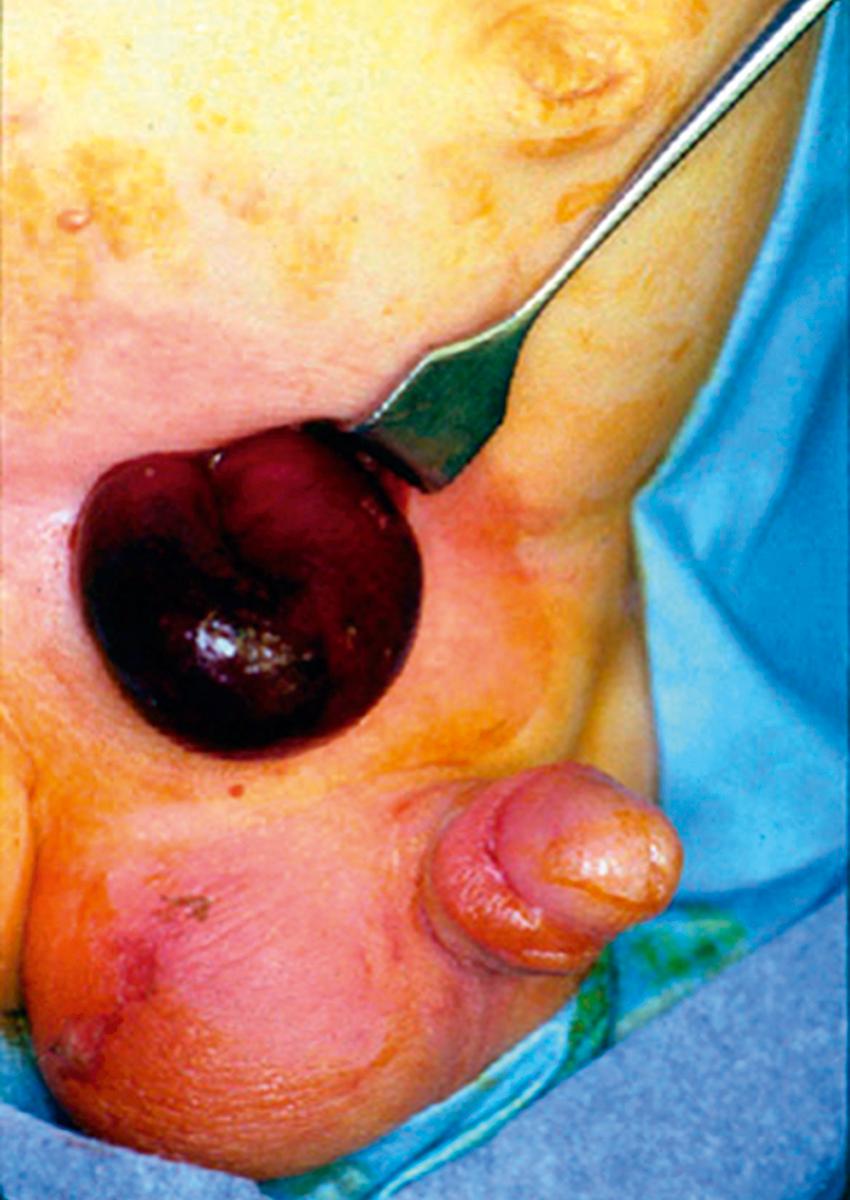
It is sometimes stated that gangrenous or ischemic bowel cannot be reduced, but exceptions make this a dangerous rule to rely on. The presence of peritonitis, hemodynamic instability, or septic shock is an absolute contraindication to attempted reduction. Symptoms of bowel obstruction are a relative contraindication. Monitored conscious sedation is used after intravenous access and rehydration. Firm and continuous pressure is applied around the incarceration. Successful reduction is usually confirmed by a sudden “pop” of the contents back into the peritoneal cavity. Questionable or incomplete reductions should be explored. Reduction en mass, in which the hernia contents are reduced into the peritoneal cavity but the bowel remains incarcerated internally in the hernia sac, is a very rare occurrence, but the surgeon should be aware of this possibility.
After reduction of an incarcerated hernia, a delay of 24–48 hours to allow resolution of the edema prior to open repair has historically been recommended. Delay is less important if the laparoscopic approach is planned. Reliability of the family as well as the clinical history (very difficult reduction) and geographic considerations may dictate the need for admission and observation before definitive repair. It is estimated that 70–95% of incarcerated hernias can be successfully reduced. In one report of 743 incarcerated hernias, only 8% required an emergency operation and 2 children required bowel resection.
An urgent operation is necessary if reduction of the hernia contents is unsuccessful or incomplete. We prefer the laparoscopic approach for incarcerated hernias ( Fig. 50.11 ), and there is evidence that the laparoscopic approach is associated with fewer complications. Using laparoscopic traction and manual external pressure, it is usually possible to reduce the hernia contents. The intestine or appendix can be exteriorized through the umbilicus for examination or to perform a bowel resection or appendectomy in the rare event resection is needed.

On occasion, the hernia may spontaneously reduce with induction of general anesthesia. If laparoscopy is planned, it should proceed. Once the hernia contents are reduced, the repair is as described elsewhere in this chapter. In an open repair, bloody fluid or enteric contents from the open sac mandate additional investigation. A laparoscope can be inserted through the sac or via the umbilicus to evaluate for intestinal injury. Alternatively, a separate incision or La Roque maneuver (incision in the transversalis through the same inguinal skin incision, above the internal inguinal ring) will allow inspection of the peritoneal contents.
With an open repair, if the bowel is still incarcerated after anesthesia has been induced, the sac is opened and viable bowel is reduced, after which a standard repair (high ligation) is done. The hernia sac is often quite edematous and friable, and repair of the hernia can be quite difficult. It may be necessary to open the internal inguinal ring laterally in order to reduce the bowel. A sliding hernia is more frequent in incarcerated hernias, particularly in girls. Ischemic intestine can be resected via the inguinal incision and an anastomosis performed (see Fig. 50.10 ), or a laparoscopic or open abdominal approach can be utilized as well (see Fig. 50.11 ). Even with incarceration, intestinal injury requiring resection is rare (1–2%).
Postoperative complications are significantly increased in incarcerated hernias compared with elective repairs. The risk of recurrence is significantly increased in the presence of incarceration. Wound infections are increased, as are inadvertent injuries to the vas deferens and other organs.
The parents of a boy with an incarcerated hernia should be counseled preoperatively about the possibility of testicular loss or injury because of the incarceration impinging on the blood supply to this end organ ( Fig. 50.12 ). The testis on the incarcerated side in males is often edematous and somewhat cyanotic. Even a threatened, ischemic testis should be preserved unless it is clearly necrotic. The incidence of testicular atrophy is 2–3%.
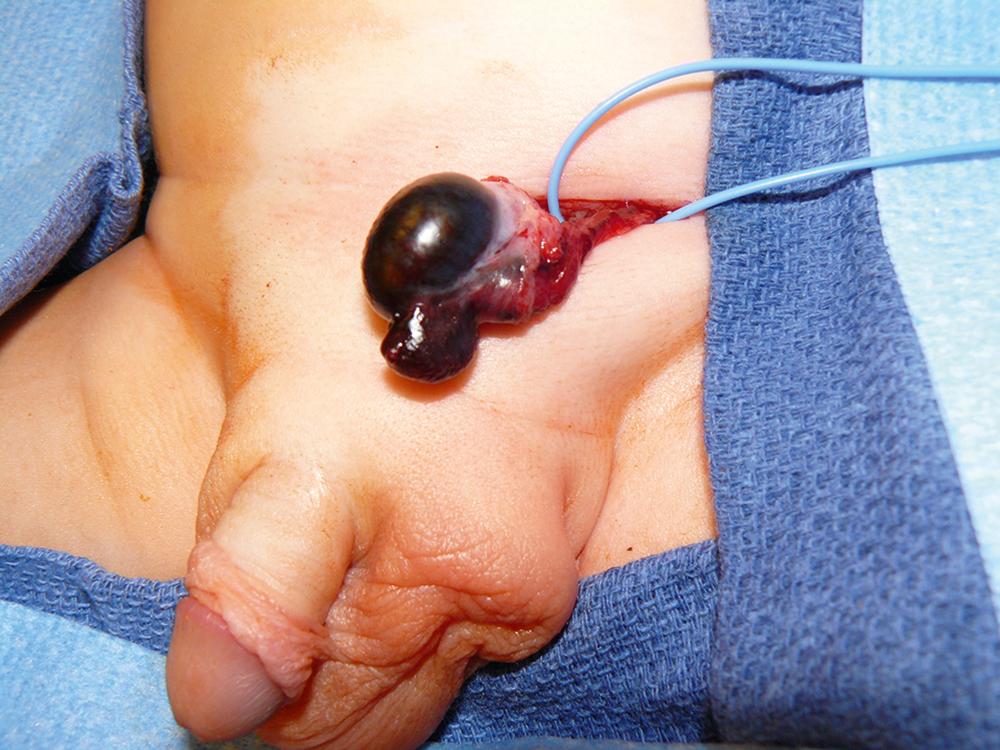
In girls who have an incarcerated hernia, the ovary and/or fallopian tube are more commonly involved than is intestine (see Fig. 50.4 ). If the ovary is incarcerated on examination in an otherwise asymptomatic infant, its blood supply is usually unaffected. However, most pediatric surgeons will promptly (but not emergently) repair the hernia in a girl with an asymptomatic, nontender ovarian incarceration. The ovary is more likely to be compromised from torsion, as opposed to compression of the vessels with incarceration.
Become a Clinical Tree membership for Full access and enjoy Unlimited articles
If you are a member. Log in here